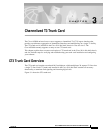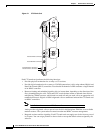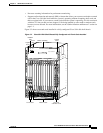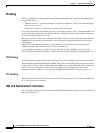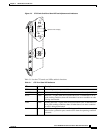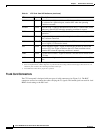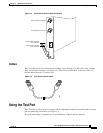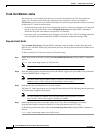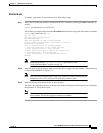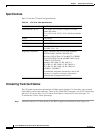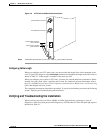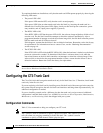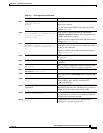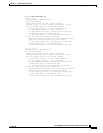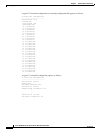
3-12
Cisco AS5800 Universal Access Server Dial Shelf Card Guide
78-7097-03
Chapter 3 Channelized T3 Trunk Card
Configuring the CT3 Trunk Card
To complete the hardware installation, verify that the trunk card LEDs operate properly by observing the
following LED states:
• The power LED is ON.
If the power LED remains OFF, verify that the card is seated properly.
If the power LED lights on other trunk cards in the dial shelf, try inserting the trunk card in a
different slot. If none of the power LEDs lights, check your dial shelf power connections, power
entry modules, and AC-input power supplies (if present).
• The HCPU LED is ON.
If the HCPU LED is OFF but the power LED is ON, the software image might have failed to load
onto the card. The dial shelf controller attempts to reload the software automatically. After a
programmed number of attempts to reload the software image fails, the dial shelf controller powers
OFF the trunk card and all LEDs are shut off.
If this happens, assume that the failure is due to defective hardware. Return the card to the factory
for replacement. For information on how to contact Cisco, see the “Obtaining Documentation”
section on page xiv.
• The FCPU LED is ON.
If the FCPU LED is OFF while the HCPU LED is ON, either the hardware is defective or the framer
processor software has crashed. To determine if the failure is software related, wait while the
auto-reload feature on the dial shelf controller card attempts to reload the software image. If the
software fails to reload after the programmed number of times, assume that the failure is due to
defective hardware. Return the card to the factory for replacement.
Tips For further installation troubleshooting information, refer to the Cisco AS5800 Universal
Access Server Hardware Installation Guide.
Configuring the CT3 Trunk Card
The Cisco 5814 dial shelf recognizes trunk cards only in dial shelf slots 0 to 5. Therefore, install trunk
cards only in the first six slots.
If you are replacing a dial shelf card by installing a new dial shelf card of the same type in the same slot,
the system software recognizes the new dial shelf card interfaces and brings them up automatically. No
additional configuration is needed.
If you are installing a trunk card in a different slot than the trunk card you just removed, additional
configuration is needed. Refer to the Cisco AS5800 Universal Access Server Operation, Administration,
Maintenance, and Provisioning Guide that shipped with your system.
Configuration Commands
Table 3-3 lists commands to help you configure your CT3 card.
Note The / symbol is used in commands to specify a physical location. Thus 1/0/0 on a T3 port
tells you where you can plug something in to the dial shelf. The : symbol is used in
commands to specify a TDM channel within a physical port.



